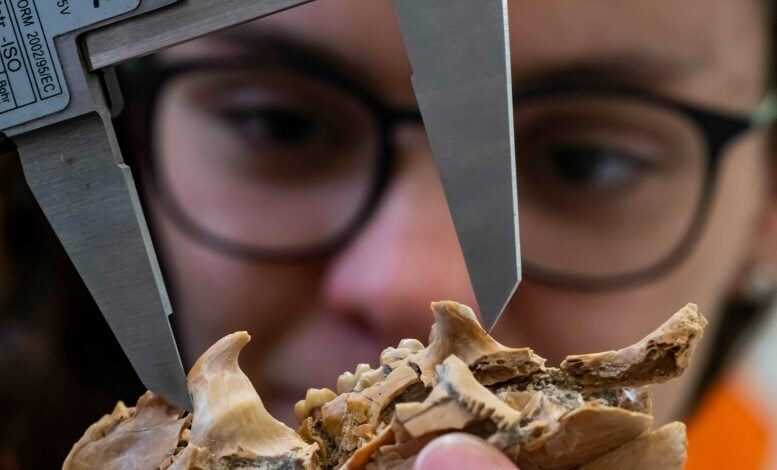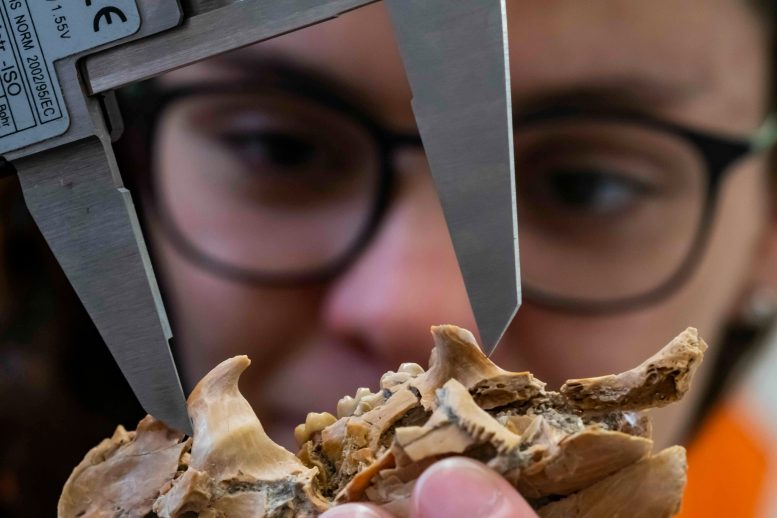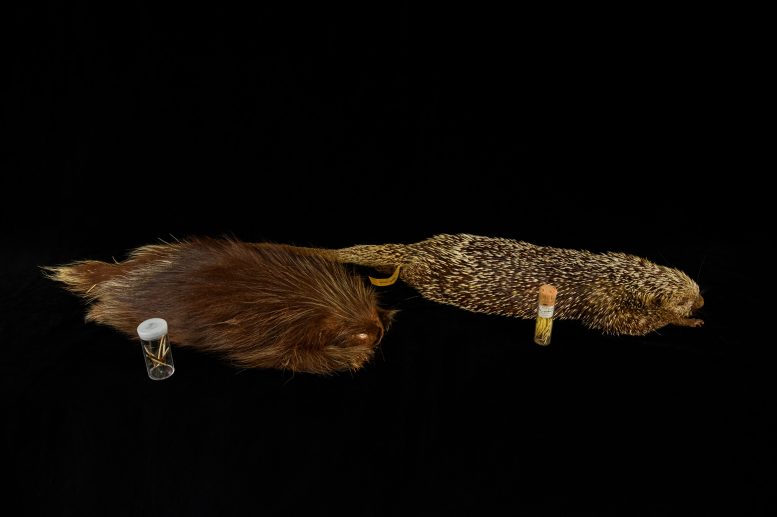Ancient Porcupine Discovery Solves Evolutionary Mystery 10 Million Years in the Making


Biologists and paleontologists have long debated the origins of North American porcupines, with DNA suggesting a 10 million year history, while fossils indicate they may have evolved only 2.5 million years ago. A new study, leveraging a nearly complete porcupine skeleton found in Florida, has clarified this timeline by comparing anatomical differences with South American species, concluding North American porcupines are indeed an ancient group. The study, supported by a unique college course, also explored the broader migratory and evolutionary patterns of porcupines and other mammals across continents, highlighting how environmental changes shaped their adaptations and survival. Credit: Florida Museum photo by Jeff Gage
New findings from a complete porcupine skeleton in Florida reveal a much earlier origin for North American porcupines, predating the Isthmus of Panama, and suggest a mixed evolutionary lineage with traits of both North and South American species.
There’s a longstanding debate simmering among biologists who study porcupines. In Central and South America, there are 16 species of porcupines, while North America has just one. Genetic data indicates that this lone North American porcupine is part of a lineage that dates back 10 million years. However, fossil records provide a contrasting narrative, suggesting that they might have evolved only 2.5 million years ago, at the beginning of the ice ages.
A new study published in the journal Current Biology claims to have reconciled the dispute, thanks to an exceptionally rare, nearly complete porcupine skeleton discovered in Florida. The authors reached their conclusion by studying key differences in bone structure between North and South American porcupines, but getting there wasn’t easy. It took an entire class of graduate and undergraduate students and several years of careful preparation and study.
“Even for a seasoned curator with all the necessary expertise, it takes an incredible amount of time to fully study and process an entire skeleton,” said lead author Natasha Vitek. While studying as a doctoral student at the Florida Museum of Natural History, Vitek teamed up with vertebrate paleontology curator Jonathan Bloch to create a college course in which students got hands-on research experience by studying porcupine fossils.
Ancient radiation gave rise to the world’s largest rodents
Porcupines are a type of rodent, and their ancestors likely originated in Africa more than 30 million years ago. Their descendants have since wandered into Asia and parts of Europe by land, but their journey to South America is a particularly defining event in the history of mammals. They crossed the Atlantic Ocean — likely by rafting — when Africa and South America were much closer together than they are today. They were the first rodents to ever set foot on the continent, where they evolved into well-known groups like guinea pigs, chinchillas, capybaras, and porcupines.
Some took on giant proportions. There were lumbering, rat-like animals up to five feet long, equipped with a tiny brain that weighed less than a plum. Extinct relatives of the capybara grew to the size of cows.
Porcupines remained relatively small and evolved adaptations for life in the treetops of South America’s lush rainforests. Today, they travel through the canopy with the aid of long fingers capped with blunt, sickle-shaped claws perfectly angled for gripping branches. Many also have long, prehensile tails capable of bearing their weight, which they use while climbing and reaching for fruit.

North (left) and South (right) American porcupines have been on separate evolutionary trajectories for as long as 10 million years. Credit: Florida Museum photo by Kristen Grace
Despite their excellent track record of getting around, South America was a dead end for many millions of years. A vast seaway with swift currents separated North and South America, and most animals were unable to cross — with a few notable exceptions.
Beginning about 5 million years ago, the Isthmus of Panama rose above sea level, cutting off the Pacific from the Atlantic. This land bridge became the ancient equivalent of a congested highway a few million years later, with traffic flowing in both directions.
Prehistoric elephants, saber-toothed cats, jaguars, llamas, peccaries, deer, skunks, and bears streamed from North America to South. The reverse trek was made by four different kinds of ground sloths, oversized armadillos, terror birds, capybaras, and even a marsupial.
The two groups met with radically different fates. Those mammals migrating south did fairly well; many became successfully established in their new tropical environments and survived to the present. But nearly all lineages that ventured north into colder environments have gone extinct. Today, there are only three survivors: the nine-banded armadillo, the Virginia opossum, and the North American porcupine.
New fossils catch evolution in the act
Animals that traveled north had to contend with new environments that bore little resemblance to the ones they left behind. Warm, tropical forests gave way to open grasslands, deserts, and cold deciduous forests. For porcupines, this meant coping with brutal winters, fewer resources and coming down from the trees to walk on land. They still haven’t quite gotten the hang of the latter; North American porcupines have a maximum ground speed of about 2 mph.
South American porcupines are equipped with a menacing coat of hollow, overlapping quills, which offer a substantial amount of protection but do little to regulate body temperature. North American porcupines replaced these with a mix of insulating fur and long, needle-like quills that can be raised when they feel threatened. They also had to modify their diet, which changed the shape of their jaw.
“In winter, when their favorite foods are not around, they will bite into tree bark to get at the softer tissue underneath. It’s not great food, but it’s better than nothing,” Vitek said. “We think this type of feeding selected for a particular jaw structure that makes them better at grinding.”
They also lost their prehensile tails. Although North American porcupines still like climbing, it’s not their forte. Museum specimens often show evidence of healed bone fractures, likely caused by falling from trees.
Many of these traits can be observed in fossils. The problem is there aren’t many fossils to go around. According to Vitek, most are either individual teeth or jaw fragments, and researchers often lump them in with South American porcupines. Those that are considered to belong to the North American group lack the critical features that would provide paleontologists with clues to how they evolved.
So when Florida Museum paleontologist Art Poyer found an exquisitely preserved porcupine skeleton in a Florida limestone quarry, they were well aware of its significance.
“When they first brought it in, I was amazed,” said Bloch, senior author of the study. “It is so rare to get fossil skeletons like this with not only a skull and jaws, but many associated bones from the rest of the body. It allows for a much more complete picture of how this extinct mammal would have interacted with its environment. Right away we noticed that it was different from modern North American porcupines in having a specialized tail for grasping branches.”
By comparing the fossil skeleton with bones from modern porcupines, Bloch and Vitek were confident they could determine its identity. But the amount of work this would require was more than one person could do on their own in a short amount of time. So they co-created a paleontology college course, in which the only assignment for the entire semester was studying porcupine bones.
“It’s the kind of thing that could only be taught at a place like the Florida Museum, where you have both collections and enough students to study them,” Vitek said. “We focused on details of the jaw, limbs, feet, and tails. It required a very detailed series of comparisons that you might not even notice on the first pass.”
The results were surprising. The fossil lacked the reinforced bark-gnawing jaws and possessed a prehensile tail, making it appear more closely related to South American porcupines. But, Vitek said, other traits bore a stronger similarity to North American porcupines, including the shape of the middle ear bone as well as the shapes of the lower front and back teeth.
With all the data combined, analyses consistently provided the same answer. The fossils belonged to an extinct species of North American porcupine, meaning this group has a long history that likely began before the Isthmus of Panama had formed. But questions remain as to how many species once existed in this group or why they went extinct.
“One thing that isn’t resolved by our study is whether these extinct species are direct ancestors of the North American porcupine that is alive today,” Vitek said. “It’s also possible porcupines got into temperate regions twice, once along the Gulf Coast and once out west. We’re not there yet.”
Reference: “An extinct north American porcupine with a South American tail” by Natasha S. Vitek, Jennifer C. Hoeflich, Isaac Magallanes, Sean M. Moran, Rachel E. Narducci, Victor J. Perez, Jeanette Pirlo, Mitchell S. Riegler, Molly C. Selba, María C. Vallejo-Pareja, Michael J. Ziegler, Michael C. Granatosky, Richard C. Hulbert and Jonathan I. Bloch, 27 May 2024, Current Biology.
DOI: 10.1016/j.cub.2024.04.069
The study was funded by the U.S. National Science Foundation.
Jennifer Hoeflich, Isaac Magallanes, Sean Moran, Rachel Narducci, Victor Perez, Jeanette Pirlo, Mitchell Riegler, Molly Selba, María Vallejo-Pareja, Michael Ziegler, Michael Granatosky and Richard Hulbert of the Florida Museum of Natural History are also authors on the paper.


